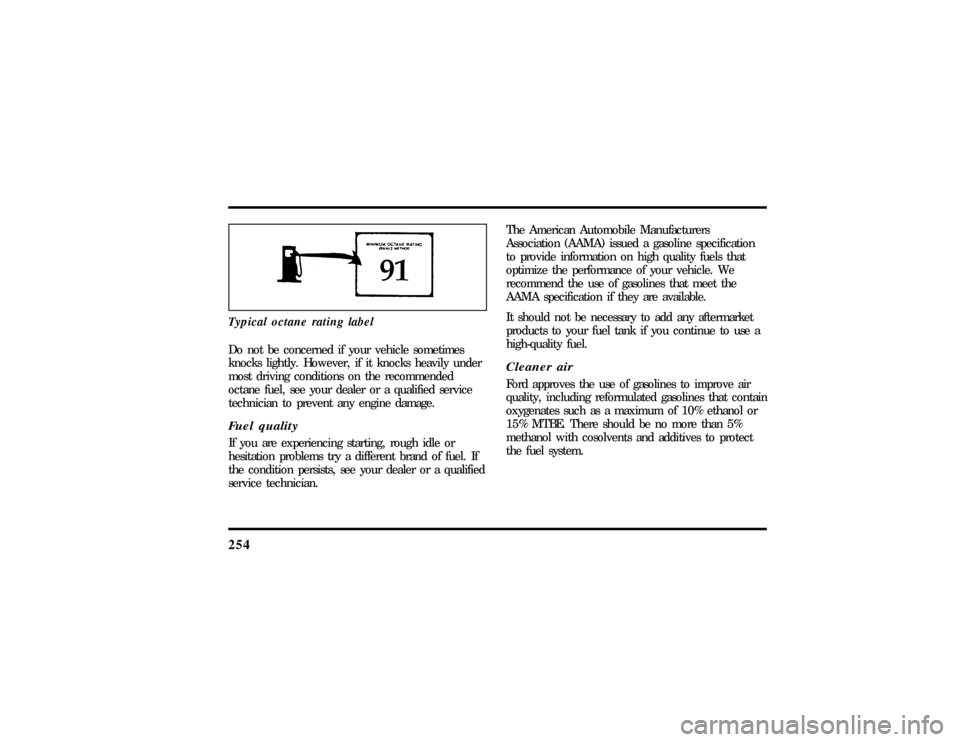Page 226 of 321
225
Engine compartment service points
File:11fnmcc.ex
Update:Fri Sep 6 08:51:16 1996
Page 236 of 321

235
Engine Coolant Refill ProcedureProper procedures for a complete coolant drain and
flush of the cooling system can be found in theCar
Service Manual.Following these recommended
procedures will ensure that the specified coolant
level and a 50/50 or appropriate mixture of coolant
and water is maintained.Engine Coolant Refill ProcedureWhen the entire cooling system is drained and
refilled, the following procedure should be used to
ensure a complete fill:
NOTE:It is imperative the following procedure be
adhered to. Failure to do so could result in damage
to your engine.q
Remove coolant reservoir pressure cap.
q
Remove the engine coolant outlet tube fill plug
on the engine.
q
With the engine off and cool, add a 50/50
mixture of recommended cooling system fluid
and water to the coolant outlet tube fill neck
until the reservoir is full.
NOTE:DO NOT FILL COOLANT SYSTEM
THROUGH COOLANT RESERVOIR. COOLANT
WILL NOT ENTER ENGINE, WHICH CAN LEAD
TO ENGINE DAMAGE.
NOTE:Avoid spilling coolant on the front end
accessory drive belt, as this will allow the belt to
slip and become noisy.
q
Reinstall the pressure cap to the coolant
reservoir.
q
Continue filling at the engine coolant tube fill
neck slowly while allowing air to escape.
q
Reinstall the engine coolant tube fill plug when
the system is full.
File:11fnmcc.ex
Update:Fri Sep 6 08:51:16 1996
Page 245 of 321

244Pressure Alert SystemEach of your SecuriTires is monitored by a low tire
pressure sensor. A warning will appear in the
overhead console when the pressure in one of your
tires drops below acceptable levels or if the system
has malfunctioned.
The Low Tire Pressure warning in the
overhead console
THIS DEVICE COMPLIES WITH FCC RULES,
PART 15. OPERATION IS SUBJECT TO THE
FOLLOWING TWO CONDITIONS: (1) THIS
DEVICE MAY NOT CAUSE HARMFUL
INTEREFERENCE AND (2) THIS DEVICE MUST
ACCEPT ANY INTEREFERENCE THAT MAY BE
RECEIVED, INCLUDING INTEREFERENCE THAT
MAY CAUSE UNDESIRABLE OPERATION.Maintenance WarningThe ªLow Tire Pressureº warning will illuminate
and stay on when one of your vehicle's tires drops
below 18 psi (124 kps). The warning light will also
come on and stay lit if the Pressure Alert System
has malfunctioned.
If this warning appears, check the pressure in your
tires at the earliest possible convenience and adjust
any tire that is low to the recommended air
pressure level. This information can be found on
theService Station Informationpage at the back of
this manual or on the driver's door placard.
File:11fnmcc.ex
Update:Fri Sep 6 08:51:16 1996
Page 250 of 321

249
Information About Tire Quality GradesNew vehicles are fitted with tires that have their
Tire Quality Grade (described below) molded into
the tire's sidewall. These Tire Quality Grades are
determined by standards that the United States
Department of Transportation has set.
Tire Quality Grades apply to new pneumatic tires
for use on passenger cars. They do not apply to
deep tread, winter-type snow tires, space-saver or
temporary use spare tires, tires with nominal rim
diameters of 10 to 12 inches or limited production
tires as defined in Title 49 Code of Federal
Regulations Part 575.104(c)(2).
U.S. Department of Transportation Ð Tire
quality grades:The U.S. Department of
Transportation requires Ford to give you the
following information about tire grades exactly as
the government has written it.
TreadwearThe treadwear grade is a comparative rating based
on the wear rate of the tire when tested under
controlled conditions on a specified government test
course. For example, a tire graded 150 would wear
one and one-half (1 1/2) times as well on the
government course as a tire graded 100. The
relative performance of tires depends upon the
actual conditions of their use, however, and may
depart significantly from the norm due to variations
in driving habits, service practices and differences in
road characteristics and climate.Traction A B CThe traction grades, from highest to lowest, are A,
B, and C, and they represent the tire's ability to
stop on wet pavement as measured under controlled
conditions on specified government test surfaces of
asphalt and concrete. A tire marked C may have
poor traction performance.
File:11fnmcc.ex
Update:Fri Sep 6 08:51:16 1996
Page 255 of 321

254Typical octane rating labelDo not be concerned if your vehicle sometimes
knocks lightly. However, if it knocks heavily under
most driving conditions on the recommended
octane fuel, see your dealer or a qualified service
technician to prevent any engine damage.Fuel qualityIf you are experiencing starting, rough idle or
hesitation problems try a different brand of fuel. If
the condition persists, see your dealer or a qualified
service technician.The American Automobile Manufacturers
Association (AAMA) issued a gasoline specification
to provide information on high quality fuels that
optimize the performance of your vehicle. We
recommend the use of gasolines that meet the
AAMA specification if they are available.
It should not be necessary to add any aftermarket
products to your fuel tank if you continue to use a
high-quality fuel.
Cleaner airFord approves the use of gasolines to improve air
quality, including reformulated gasolines that contain
oxygenates such as a maximum of 10% ethanol or
15% MTBE. There should be no more than 5%
methanol with cosolvents and additives to protect
the fuel system.
File:11fnmcc.ex
Update:Fri Sep 6 08:51:16 1996
Page 258 of 321

257
q
English: MPG = (total miles)/(gallons used).
q
Metric: L/100K = (liters used) x 100/(total
kilometers)
Comparisons With Environmental
Protection Agency (EPA) and Transport
Canada (TC) Fuel Economy EstimatesEPA fuel economy figures are obtained from
laboratory tests under simulated road conditions and
may not reflect the actual conditions you experience
or your style of driving. The EPA fuel economy
estimate is not a guarantee that you will achieve
the fuel economy shown.
The following decrease fuel economy:q
Lack of regular, scheduled maintenance
q
Rapid acceleration and excessive speed
q
Driving with your foot on the brake
q
Sudden stops
q
Extended engine idling
q
Using speed control in hilly terrain
q
Extended use of the A/C, defroster, rear
window defroster and other accessories
q
Underinflated tires
q
Heavy loads
q
Aftermarket add-ons such as bike, ski or luggage
racks, bug deflectors, etc.
Self-Service PointersIf you choose to do your own fueling, you should
also perform a few simple maintenance routines.
This extra effort will save you additional money and
contribute to the driving efficiency of your vehicle.
File:11fnmcc.ex
Update:Fri Sep 6 08:51:16 1996
Page 261 of 321

260Do not make any unauthorized changes to your
vehicle or engine. Changes that cause more
unburned fuel to reach the exhaust system can
increase the temperature of the engine or exhaust
system.
By law, anyone who manufactures, repairs, services,
sells, leases, trades vehicles, or supervises a fleet of
vehicles is not permitted to intentionally remove an
emission control device or prevent it from working.
In some of the United States and in Canada,
vehicle owners may be liable if their emission
control device is removed or is prevented from
working.
Do not drive your vehicle if it does not operate
properly. See your dealer if the engine runs on for
more than five seconds after you shut it off or if it
misfires, surges, stalls, or backfires.Information about your vehicle's emission control
system is on the Vehicle Emission Control
Information decal located on or near the engine.
This decal identifies engine displacement and gives
some tune-up specifications.
How to Prepare Your Vehicle for
Inspection/Maintenance (I/M) TestingIn some localities it may become a legal
requirement to pass an Inspection/Maintenance
(I/M) test of the On-Board Diagnostic (OBD) II
system. If the vehicle's powertrain system or its
battery has just been serviced, the OBD II system is
reset to a not ready for I/M testing condition. To
prepare for I/M testing, the law specifies that
additional mixed city and highway driving is
required to complete the check of the OBD II
system.
File:11fnmcc.ex
Update:Fri Sep 6 08:51:16 1996
Page 278 of 321

279
Customer AssistanceIf You Have a Service ProblemFord Motor Company has authorized Ford and
Lincoln-Mercury dealerships that can service your
vehicle for you. This chapter tells you how to get
service or maintenance for your vehicle.Service/Maintenance Concerns
(U.S. or Canada)Ford recommends taking your vehicle to your
selling dealer who wants to ensure your continued
satisfaction. You may, however, take your vehicle to
any authorized Ford or Lincoln-Mercury dealer. In
most cases, your dealer will be able to resolve your
concern.If you are not satisfied with the service you
received from your dealership's service department,
talk to the service manager at the dealership, or if
you still are not satisfied, talk to the owner or
general manager of the dealership. In most cases,
you will have your concern resolved at this level.
If you are away from home when your vehicle
needs to be serviced, or if you need more help than
the dealer gave you, contact the Ford Customer
Assistance Center to find an authorized dealership
that may be able to help you.
File:14fnhsc.ex
Update:Mon Sep 9 10:16:08 1996